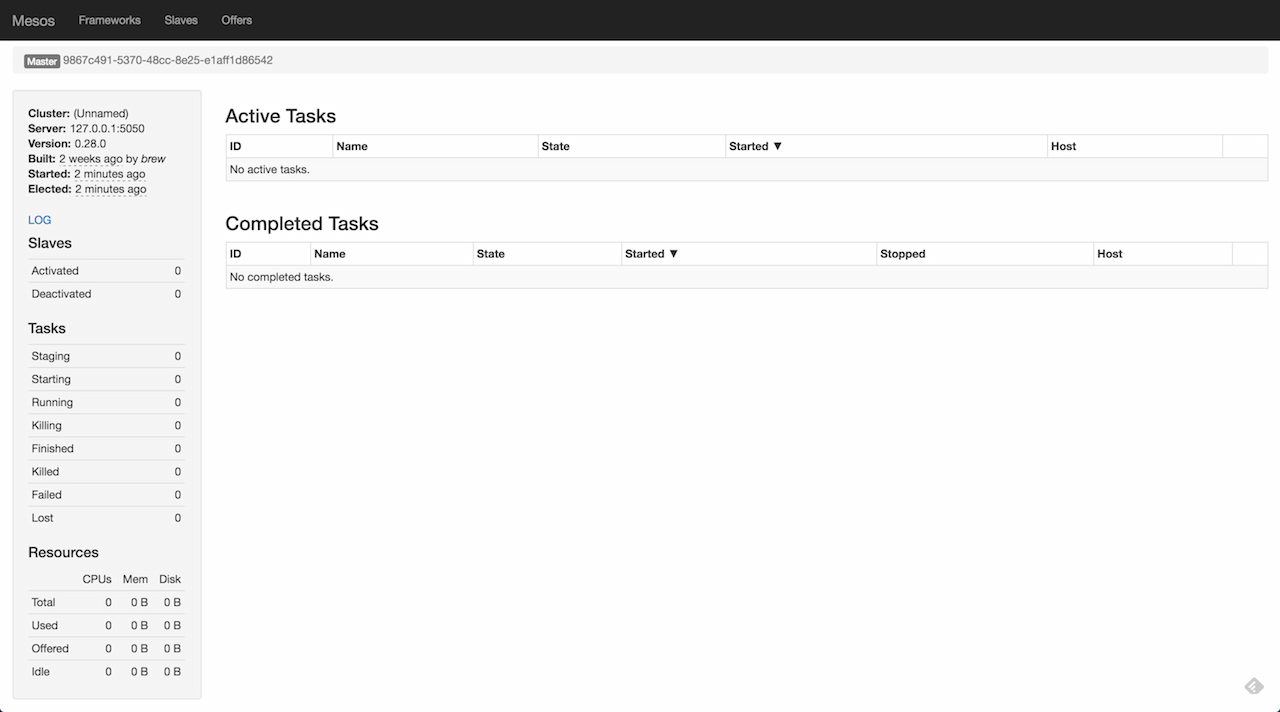
Spark on Mesos

Running Spark on Mesos
A Mesos cluster needs at least one Mesos Master to coordinate and dispatch tasks onto Mesos Slaves.
$ mesos-master --registry=in_memory --ip=127.0.0.1
I0401 00:12:01.955883 1916461824 main.cpp:237] Build: 2016-03-17 14:20:58 by brew
I0401 00:12:01.956457 1916461824 main.cpp:239] Version: 0.28.0
I0401 00:12:01.956538 1916461824 main.cpp:260] Using 'HierarchicalDRF' allocator
I0401 00:12:01.957381 1916461824 main.cpp:471] Starting Mesos master
I0401 00:12:01.964118 1916461824 master.cpp:375] Master 9867c491-5370-48cc-8e25-e1aff1d86542 (localhost) started on 127.0.0.1:5050
...Visit the management console at http://localhost:5050.

Run Mesos Slave onto which Master will dispatch jobs.
$ mesos-slave --master=127.0.0.1:5050
I0401 00:15:05.850455 1916461824 main.cpp:223] Build: 2016-03-17 14:20:58 by brew
I0401 00:15:05.850772 1916461824 main.cpp:225] Version: 0.28.0
I0401 00:15:05.852812 1916461824 containerizer.cpp:149] Using isolation: posix/cpu,posix/mem,filesystem/posix
I0401 00:15:05.866186 1916461824 main.cpp:328] Starting Mesos slave
I0401 00:15:05.869470 218980352 slave.cpp:193] Slave started on 1)@10.1.47.199:5051
...
I0401 00:15:05.906355 218980352 slave.cpp:832] Detecting new master
I0401 00:15:06.762917 220590080 slave.cpp:971] Registered with master [email protected]:5050; given slave ID 9867c491-5370-48cc-8e25-e1aff1d86542-S0
...Switch to the management console at http://localhost:5050/#/slaves to see the slaves available.

|
Important
|
You have to export |
|
Note
|
The preferred approach to launch Spark on Mesos and to give the location of Spark binaries is through spark.executor.uri setting. For us, on a bleeding edge of Spark development, it is very convenient to use spark.mesos.executor.home setting, instead. |
$ ./bin/spark-shell --master mesos://127.0.0.1:5050 -c spark.mesos.executor.home=`pwd`
...
I0401 00:17:41.806743 581939200 sched.cpp:222] Version: 0.28.0
I0401 00:17:41.808825 579805184 sched.cpp:326] New master detected at [email protected]:5050
I0401 00:17:41.808976 579805184 sched.cpp:336] No credentials provided. Attempting to register without authentication
I0401 00:17:41.809605 579268608 sched.cpp:703] Framework registered with 9867c491-5370-48cc-8e25-e1aff1d86542-0001
Spark context available as sc (master = mesos://127.0.0.1:5050, app id = 9867c491-5370-48cc-8e25-e1aff1d86542-0001).
...In Frameworks tab you should see a single active framework for spark-shell.

|
Tip
|
Consult slave logs under /tmp/mesos/slaves when facing troubles.
|
|
Important
|
Ensure that the versions of Spark of spark-shell and as pointed out by spark.executor.uri are the same or compatible.
|
scala> sc.parallelize(0 to 10, 8).count
res0: Long = 11
Stop Spark shell.
scala> Stopping spark context.
I1119 16:01:37.831179 206073856 sched.cpp:1771] Asked to stop the driver
I1119 16:01:37.831310 698224640 sched.cpp:1040] Stopping framework '91979713-a32d-4e08-aaea-5dffbfd44e5d-0002'CoarseMesosSchedulerBackend
CoarseMesosSchedulerBackend is the scheduler backend for Spark on Mesos.
It requires a Task Scheduler, Spark context, mesos:// master URL, and Security Manager.
It is a specialized CoarseGrainedSchedulerBackend and implements Mesos’s org.apache.mesos.Scheduler interface.
It accepts only two failures before blacklisting a Mesos slave (it is hardcoded and not configurable).
It tracks:
-
the number of tasks already submitted (
nextMesosTaskId) -
the number of cores per task (
coresByTaskId) -
the total number of cores acquired (
totalCoresAcquired) -
slave ids with executors (
slaveIdsWithExecutors) -
slave ids per host (
slaveIdToHost) -
task ids per slave (
taskIdToSlaveId) -
How many times tasks on each slave failed (
failuresBySlaveId)
|
Tip
|
createSchedulerDriver instantiates Mesos’s org.apache.mesos.MesosSchedulerDriver
|
CoarseMesosSchedulerBackend starts the MesosSchedulerUtils-mesos-driver daemon thread with Mesos’s org.apache.mesos.MesosSchedulerDriver.
Default Level of Parallelism
The default parallelism is controlled by spark.default.parallelism.
Settings
-
spark.default.parallelism(default:8) - the number of cores to use as Default Level of Parallelism. -
spark.cores.max(default:Int.MaxValue) - maximum number of cores to acquire -
spark.mesos.extra.cores(default:0) - extra cores per slave (extraCoresPerSlave) FIXME -
spark.mesos.constraints(default: (empty)) - offer constraints FIXMEslaveOfferConstraints -
spark.mesos.rejectOfferDurationForUnmetConstraints(default:120s) - reject offers with mismatched constraints in seconds -
spark.mesos.executor.home(default:SPARK_HOME) - the home directory of Spark for executors. It is only required when nospark.executor.uriis set.
(Fine)MesosSchedulerBackend
When spark.mesos.coarse is false, Spark on Mesos uses MesosSchedulerBackend
Settings
-
spark.mesos.coarse(default:true) controls whether the scheduler backend for Mesos works in coarse- (CoarseMesosSchedulerBackend) or fine-grained mode (MesosSchedulerBackend).
|
Caution
|
FIXME Review
|
Schedulers in Mesos
Available scheduler modes:
-
fine-grained mode
-
coarse-grained mode -
spark.mesos.coarse=true
The main difference between these two scheduler modes is the number of tasks per Spark executor per single Mesos executor. In fine-grained mode, there is a single task in a single Spark executor that shares a single Mesos executor with the other Spark executors. In coarse-grained mode, there is a single Spark executor per Mesos executor with many Spark tasks.
Coarse-grained mode pre-starts all the executor backends, e.g. Executor Backends, so it has the least overhead comparing to fine-grain mode. Since the executors are up before tasks get launched, it is better for interactive sessions. It also means that the resources are locked up in a task.
Spark on Mesos supports dynamic allocation in the Mesos coarse-grained scheduler since Spark 1.5. It can add/remove executors based on load, i.e. kills idle executors and adds executors when tasks queue up. It needs an external shuffle service on each node.
Mesos Fine-Grained Mode offers a better resource utilization. It has a slower startup for tasks and hence it is fine for batch and relatively static streaming.
Commands
The following command is how you could execute a Spark application on Mesos:
./bin/spark-submit --master mesos://iq-cluster-master:5050 --total-executor-cores 2 --executor-memory 3G --conf spark.mesos.role=dev ./examples/src/main/python/pi.py 100Other Findings
Spark workloads can also be sensitive to the physical characteristics of the infrastructure, such as memory size of the node, access to fast solid state disk, or proximity to the data source.
to run Spark workloads well you need a resource manager that not only can handle the rapid swings in load inherent in analytics processing, but one that can do to smartly. Matching of the task to the RIGHT resources is crucial and awareness of the physical environment is a must. Mesos is designed to manage this problem on behalf of workloads like Spark.